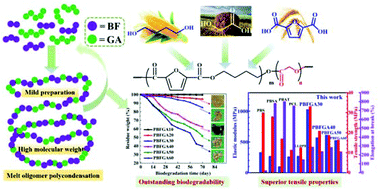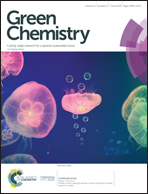A mild method to prepare high molecular weight poly(butylene furandicarboxylate-co-glycolate) copolyesters: effects of the glycolate content on thermal, mechanical, and barrier properties and biodegradability†
Abstract
The melt polycondensation of glycolic acid based copolymers with high molecular weights remains a big challenge. In this work, poly(butylene furandicarboxylate-co-glycolate) (PBFGA) and poly(butylene furandicarboxylate)-b-poly(glycolic acid) (PBF-b-GA) copolyesters were synthesized via melt oligomer polycondensation and melt bulk transesterification, respectively. Herein, melt oligomer polycondensation is a better method with mild preparation conditions and products with higher molecular weights (Mw). The analysis of GPC demonstrated that PBFGAs possessed a Mw of up to 8.95 × 104 g mol−1. The PBFGAs also possessed excellent thermal stability (>320 °C), which endowed the copolymers with a wider processing window than thermolabile PGA. DSC analyses displayed that PBFGA40–PBFGA10 were semi-crystalline materials that melted between 84.5 and 156 °C, while PBFGA50–60 were amorphous. Tensile tests indicated a high elastic modulus of 524–1262 MPa, tensile strength of 16–44 MPa and good elongation at break over 220% of PBFGAs, exceeding most biodegradable packaging materials. The increase of GA units slightly impacted the barrier properties, with reduced CO2 (53×) and O2 (15×) permeability coefficients than those of commercial PBAT films, and also better than those of PET. The hydrolysis of the glycolate was restrained by steric hindrance of furan rings, while in enzymatic degradation PBFGAs displayed obvious weight loss with GA units >20 mol%. With superior thermal, tensile, barrier and degradable properties, PBFGAs have the potential to serve as promising and innovative bio-based polymers for eco-friendly and sustainable plastic packaging.



 Please wait while we load your content...
Please wait while we load your content...